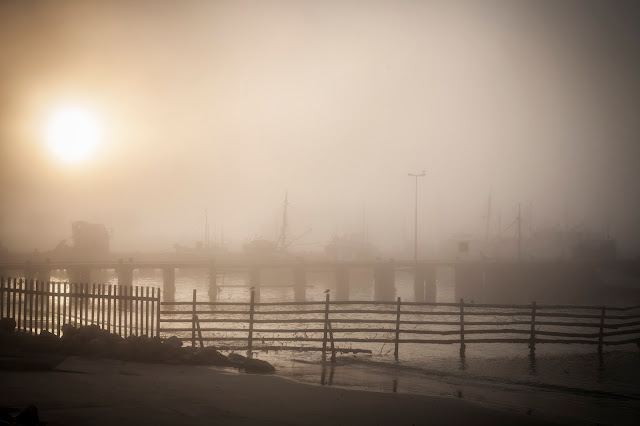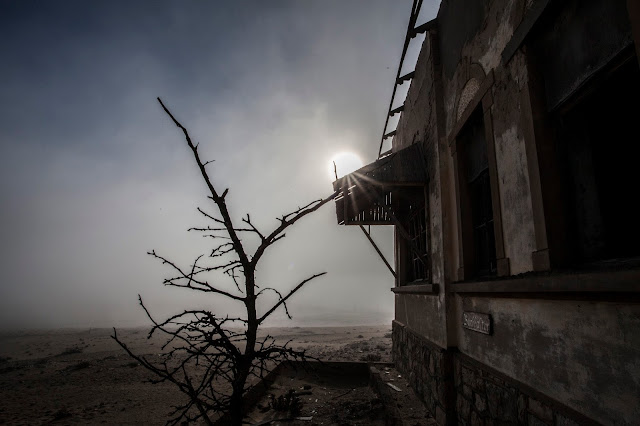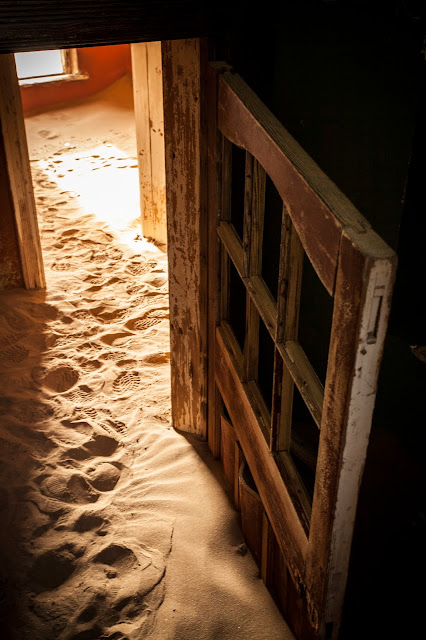Namibia. Part III: Lüderitz & Kolmanskoppe
Thanks to my husband for contributing a few photos
Lüderitz
Lüderitz is a dusty forgotten harbor in southern Namibia, lying on one of the least hospitable coasts in Africa. Naturally, that peaked our interest and it turned out to be the first stop for our whole brigade to meet and start our trek across southern Namibia.
We planned to stay 4 nights. Now, it wasn’t because of the plenitude of activities to keep us occupied, it was simply just so far away from anything that we couldn’t muster enough energy to drive the legion of hours to the secluded town and back again without some serious R&R in-between.
Honestly, I’m glad we stayed that long. It’s a little bit of desert utopia at the end of the world surrounded by a verboten zone riddled with diamonds. It’s all very exciting, to be honest. And the town itself is a diamond in the rough. Its historic town architecture is a mixture of German Imperial Style and Art Nouveau, placed between sand dunes and palm trees. It’s foggy, dusty, windy, and absolutely lovely.
My friend and I had quite a lengthy conversation about why we like Lüderitz and also why we would never ever live there. You might list the overwhelming amount of sand, the lack of civilization, being enclosed by off-limit areas or the isolated location as reasons, but they weren't. The main decider for me was the wind. The winds in Lüderitz are so fierce that between October 16th and November 26th, the town hosts an annual speed sailing challenge that many kite surfers praise as the most prestigious speed boardsailing competition in the world. This year the winds were ranging between 90 and 112 km/h (56-69,5 mph). Now please take the following into account: in 1805 a naval officer from the U.K. Royal Navy, known as Sir Francis Beaufort, designed a scale with which winds and storms can be measured. This is known as the Beaufort Scale and is used today. According to his scale, strong winds with the speed of 56-63 knots are given the numerical value of 11 and are described as "exceptionally high (37-52 ft/11-15.8m) waves, foam patches cover the sea, visibility more reduced". The only number higher than this is a 12 which represent hurricanes. Winds raging at 50 knots is "typical" in Lüderitz. I think I rest my case.
On our first day, we wanted to go gem picking on the beach. Unfortunately, this was also one of the windier days (definitely an 11). We were either walking almost parallel to the ground or were stopped mid-way - just frozen in the air as we pushed with all our might against the invisible wind wall. We were truly unsuccessful in trying to keep ourselves upright, as well as holding each other from stumbling face first and enjoying a mouthful of sand sandwich. Of course, this was a fun experience while visiting as tourists, but imagine going through that type of cardio every other day! Imagine being sandblasted while at the same time doing endurance training when all you wanted to do was buy a carton of milk and pop by the bakery.
At the entrance of one of the beaches we came across a rusty sign attached to a wooden post with a huge rock suspended from the top that read:
Weather Rock. If it’s….
Wet – it’s raining
White –it’s snowing
Swinging – it’s windy
Lying on the ground – the rope has broken
If it’s gone – there has been a tornado (or someone stole it…)
An example of Namibian humor at its best.
 |
| Borrowed from Tripadvisor.com |
The gale winds aside, we had quite a memorable visit to Lüderitz. We scoured wild and untouched beaches in a treasure hunt looking for gemstones; made friends with penguins and dolphins just off the shore in the cold Atlantic waters, enjoyed stunning vistas, and braved the godforsaken town of Kolmanskop.
Kolmanskoppe
With its back facing the Atlantic, Lüderitz is barricaded by the Sperrgebiet. It only has a small patch of land to stand on while the Sperrgebiet circles all around it. On a map, it looks a bit like a small island lost in a large sea. If the sea was an off-limits zone full of diamonds.
The Sperrgebiet meaning "Prohibited Area" is a diamond mining area of approximately 26,000 km2 (10,000 sq mi) and it makes up 3% of Namibia's land mass. They only use 5% of that area to do actual mining, the rest of is used as a buffer zone between the jewels and the public. Kolmanskop finds itself in the Sperrgebiet but the public is granted permission to enter the area for 4,5 hours a day unless you have a special photographer's pass in which case you can lounge around from sunrise to sunset.
Kolmanskop was the child of the diamond boom that hit Namibia in the beginning of the 20th century. Crowds of Germans made their way to the region and built a village in the spitting image of a town from the mother country. Despite the crass climate and isolation, the miners were rolling in cash and could afford all the luxuries from back home. They had a local butcher and baker. They had an ice plant that produced huge blocks of ice (it gets hot in the desert as you may suspect) as well as their own gelato. They had a hospital, school, power station, ballroom, bowling alley, theatre, sports hall, large swimming pool as well as a casino and it also boasted the first X-ray-station in the southern hemisphere.
They spared no expense to create a lavish oasis. Fresh water was brought in and pumped into storage tanks to maintain their lush gardens with manicured lawns, rose beds and eucalyptus trees. Life was grand in Kolmanskop.
The arrival of World War I, however, interrupted mining temporarily but soon after resumption started the deposits were slowly reaching their end. By the early 30s, the golden era of this town was in decline. News of other deposits being discovered near the Orange River caused many inhabitants to join the rush to the south and they simply up and left their homes and possessions behind. In 1956, Kolmanskop bid adieu to its last three families who finally packed up and left town.
Now 61 years later, we were trotting down the sand-swept alleys and exploring long-forgotten living rooms. It was a bone-chilling experience but the uneasiness in the air became a bit too real when someone told me that there are venomous snakes underneath the sand and "keep an eye out cause they could be anywhere". There I was, irresponsibly jumping into sand heaps, while snapping away at ruins - completely unaware of the danger that lurks beneath the surface.
Here's what Wikipedia has to say about the Sidewinder, the snake that calls Kolmanskop home: "An ambush hunter, it buries itself just beneath the surface of the sand with only its eyes and the tip of its tail exposed. When prey happens by, it is seized and envenomed." So let me get this straight: I was wandering through haunted ruins in the middle of the desert, running around kicking up sand clouds in a snake’s death playground? I was indignant to how irresponsible everyone was to only tell me about the possibility of being bitten and possibly dying after I agreed to go explore an abandoned town close to nothing. Come to a ghost town, in the middle of the world’s oldest desert, in a remote part of a huge abandoned country, surrounded by the Sperrgebiet so you can be part of a buffet for venomous camouflaging vipers. Sounds like a blast!
 |
| This is what the rooms looked like through my excited, oh so eager to get sand between my toes, point of view. |
Now take the same photo and add reality to it:
Luckily I managed to survive both ghosts and snakes that day and I only left with a slight sunburn. Visiting Kolmanskop was one of the highlights when looking back on our trip. It was a history lesson, fun in the sun, scary paranormal experience and living on the edge while trotting in a prohibited area -type of day.
I mentioned earlier that one of the reasons why I liked this place so much is because there are no ploys to make this a scary amusement park, however, after spending some time in the macabre hospital it would definitely be the ideal place for a haunted house on Halloween. Last year I visited the Eastern State Penitentiary in Philadelphia over Halloween. It is a former American prison that transforms into one of the scariest haunted houses in the world. Personally, I can testify that the penitentiary doesn't hold a candle to the spooky ambiance of Kolmanskop. All the Namibians would have to do is put on a bit of paint and simply hover in a random corner. Trust me, that would be enough to send even the most courageous into cardiac arrest. Or simply offer night passes to tourists and let the people scare themselves. They can easily charge 3 times the price for night passes and I'm confident they'll get even more guests than now. Just an idea I'm throwing out there.
Next up we braved the hot and tantalizing red sands of Sossusvlei, got chased by hyenas and became masters of the dunes.













































Comments
Post a Comment
Thanks for your input!